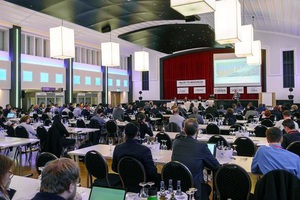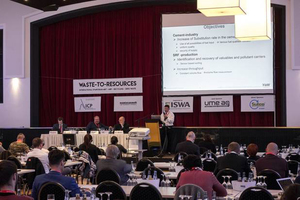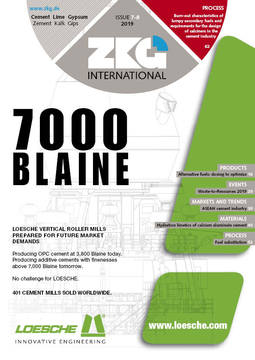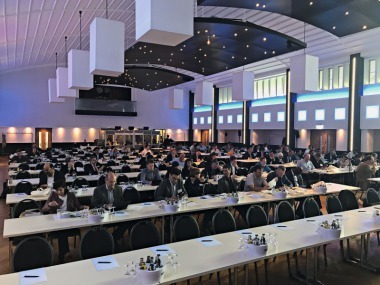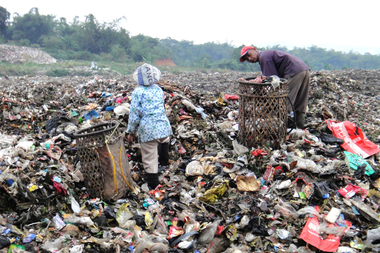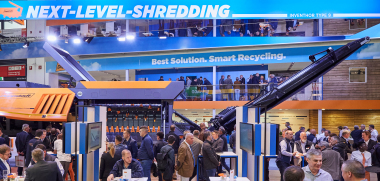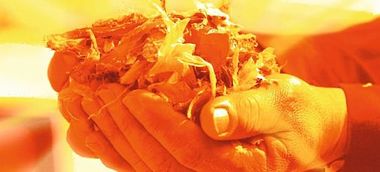Developments in waste management
in synergy with the cement market
From 14.05.-16.05.2019 around 200 participants from 32 countries joined the 8th International Symposium “Waste-to-Resources 2019“ in Hanover/Germany in order to present their newest developments and experiences in worldwide waste management. This conference is held every two years alternately with the IFAT Fair in Munich/Germany.
Challenges and chances in South America
In the past years, several countries in South America recorded many important developments in waste management and the use of residue derived fuels (RDF) as part of their integrated solid waste management plans. First and foremost, Rafaela Craizer from BlackForest Solutions GmbH spoke about the main possibilities and challenges of the production of alternative fuels in South America. Although waste to energy technologies are well developed, waste management markets in South America still suffer from the complexity of project development due to the multidisciplinary character of the ventures. According to the World Bank, Latin America and the Caribbean produced a quantity of 1.09 kg/capita/day of municipal solid waste (MSW) with an average amount of 54 % of organic waste. The main challenge in these countries is the lack of source sorting and therefore insufficient separate collection of municipal solid waste, which makes pre-sorting indispensable for reaching a necessary quality for RDF production. Due to this fact, recyclers are facing uncertainty of take-off and cement factories, on the other hand, are facing risks of unsure supply and quality. These factors result in high prices and a high uncertainty, which negatively influences the development of a needed infrastructure. Still, co-processing of MSW in cement factories remains an important and feasible solution for the growing amounts of waste in these countries. Ms. Craizer finalizes her speech with the fact that - if properly handled – the use of MSW for RDF is a win-win situation for all parties involved.
Christiane Dias Pereira, TU Braunschweig, pointed out that the development of a market for RDF in Brazil can generate significant advantages and therefore needs to be addressed urgently. The main factor is the processing of large amounts of MSW that would otherwise be landfilled, the avoidance of CO2 emissions and the substitution of fossil fuels, allowing the Brazilian a more independent market development. Regarding the potential of integration of alternative fuels (AF) from MSW in the cement market, a recent diagnostic study called PLANSAB – Energetic Report identified 25 potential clusters for the evaluation of AF projects. In the most ambitious scenario, it could be possible to process 10.5 million t of MSW per year. Considering the investment of the new management, investment of the amount of € 1.2 billion in MBT technologies will be necessary. On the other hand, the cement industry would need to invest approximately 17.5 million for the restructuring of the kiln units for the substitution of fossil fuels by AF.
Hospital waste management
Silvia Kohlmann, envitecpro GmbH, presented study results for the energy recovery possibilities of hospital waste in Porto Alegre, Brazil. 90 % of industrial, commercial and household waste is intended for final disposal to landfills. Up to today, infected hospital waste was sterilized and then without any material recovery or thermal utilization transported to a landfill near Porto Alegre. This project’s main target was the development of measures for mass reduction, usage of secondary raw materials and overall reduction of the cost of the existing waste management. Furthermore, the decentralized electricity and heat should be made available for the individual operation of the hospitals. One of the most important aspects of this project was the transfer of knowledge and experience between Brazil and Germany, so that Brazilian decision-makers could participate at workshops and visit reference facilities in Germany. The total amount of hospital waste per year in Porto Alegre amounts to 10 243.6 t, from which approximately 58 % is common and recyclable waste, 17 % biological waste and sharp objects, 16 % radioactive waste and 9 % chemical waste. Kohlmann emphasized that the project results show a great potential for the optimization of the hospital waste management. In the upcoming steps, the technical possibility for a local treatment will be calculated.
European experience
In his presentation on RDF production in MBT plants with membrane covered boxes plus biofilter, Axel Huber from Strabag Umwelttechnik stressed the importance of an overall strategy for the regional waste management as a factor for the success of waste treatment plants. The test project was conducted at an MBT plant with a capacity of 150 000 t/a in Romania that was implemented with the purpose of reducing the weight of waste before its deposition in landfills. This plant was adapted and expanded to the production of RDF for cement factories through the introduction of cost-effective composting boxes with semipermeable membrane roof in combination with a regular open biofilter. For the treatment, the waste fractions were sorted into bigger and smaller than 80 mm and a mobile ballistic separator was used for the classification of both fractions after biological treatment. All in all, the results showed that average calorific values between 17-18 Gj/t were reached and the further limit values were met. Therefore, this plant concept can be suitable for many regions to establish a cost effective treatment of MSW.
Ludwig Streff, ICP Ingenieurgesellschaft GmbH, gave an insight into his experiences in introducing a mechanical-biological treatment plant (MBT) in Sofia/Bulgaria. The main purpose of the plant was the reduction of mass through biological stabilization and secondary fuel production. Hence, the plant should contribute significantly to the reduction of emissions caused by the waste management sector. The project costs amount to a total of € 177 million and the project design and construction took a period of time of five years including a 1 year testing phase. Concerning the designed plant capacity, Streff stated that a daily treatment capacity of 1300 t, amounting to a total of 410 000 t/a, was necessary for that region. He explained that the plant was designed to produce approximately 44 % of secondary fuels, 10 % of recyclables, such as metal, glass, paper and cardboard, and less than 20 % of mass should be landfilled. After completing the necessary adaptations during the first 3 years of operation and bureaucratic difficulties in the municipal takeover, the main lesson learnt is that from the beginning fully trained staff is indispensable and can determine the success of such important projects. Therefore, the training of personnel should be included in the tender as well as the financial plan from the beginning.
An overview of the benchmarking study for improving and understanding the market of solid recovered fuel (SRF) and RDF in Europe was given by Mathilde le Bihan, RDC Environment from Brussels/Belgium. The study was conducted for French stakeholders such as the Ministry of Finance and RECORD, an association of public and private stakeholders as well as universities, with the aim of defining recommendations for the development of the French sector. She stressed that the French waste plan 2014-2025 already includes the preparation of RDF and SRF as an important measure for the reduction of landfilled non-inert non-hazardous waste (NHW), for which a total reduction potential of 2.5 Mt/a was calculated. Thus, France must acquire SRF production and consumption capacities as soon as possible. High and increasing fossil fuel prices, public policy instruments aimed at reducing landfill were defined as the main drivers for the development of RDF production. Also, the European system of CO2 quotas favoring alternative energy can contribute to a positive development. This means, that in order to support and strengthen the use of RDF from MSW, landfills and direct incineration must be more expensive, so that capacities for alternative fuels can evolve. Further measures are revenues from up- and downstream waste treatment facilities as well as increased energy prices. Le Bihan concluded her presentation with the statement that it is necessary to either build an environment of public policies favorable to RDF production or to subsidize the sector in order to enable the sector to emerge.
Regional decentralized solutions and quality improvement
Christian Eder, Wehrle Werk AG, addressed the topic of decentralized treatment of RDF and industrialized waste for small and medium-size power plants. He emphasized that particularly in consideration of lowering the CO2-footprint of RDF production and transportation, decentralized projects are an important measure for regional energy plants not only in Europe but worldwide. The company is specialized in design, construction and operation of small and medium fluidized bed systems which can treat different pre-treated waste fuels, such as RDF/SRF, industrial waste, sewage sludge and digestates. In order to generate an even distribution of the fluidization gas with a low inlet pressure, the plants contain an open nozzle floor. The material discharge occurs by a pusher, while the fluidization gas flows into the bed between the nozzle pockets and cools the material. The incineration takes place in the fluidized bed as well as the lower and post-combustion zone, all three stages are equipped with a temperature control system. Eder stated that this cost-effective technology is standardized for the power range of 2 MW and above. To conclude, Eder presented key data for an exemplary plant in Romania, which has a fuel throughput of approximately 24 000 Mg/a, operation of 8000 hours per year. The investment costs for this plant were € 11 million with a depreciation of 15 years at an interest of 3 %. The total savings on electricity supply costs amount to 183 000 €/a plus savings on renewable energy levy per ton of fuel of the amount of 12.25 €/Mg. Considering all incomes and operation costs, the processing costs of the plant for waste/RDF amount to 38.22 €/Mg.
Quality assurance is an important and decisive topic for the use of alternative fuels in cement facilities. Investigating the possibilities to improve the quality of SRF, Alexander Curtis from the University of Loeben in Austria, presented his results of the fine fraction separation. In 2017 in Austria, the thermal substitution rate was at 80.6 % for SRF in the cement production factories. Regarding this high rate, it is necessary to use SRF at several feeding ports, such as primary firing, calciner firing and rotary kiln. Therefore, the used SRF must be adjusted in order to meet the chemical and physical requirements. For the study, the test material contained packaging and mixed commercial waste and was shredded in a two-stage SRF production process and sieved into grain sizes bigger and smaller than 5 mm. After that, extensive sampling and chemical-physical analysis were conducted. The results showed that the fine material met all limiting values for heavy metals and chlorine set by the Austrian Incineration ordinance (AVV). However, the test showed that chlorine, antimony and cadmium accumulated in the coarse fraction, while mercury was more present in the fine fraction. Also, the post-shredding led to a drying of the material, thus, increasing the higher calorific value and improving the burnout behavior through the increased specific surface.
//www.waste-to-resources.eu" target="_blank" >www.waste-to-resources.eu:www.waste-to-resources.eu

